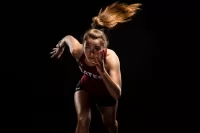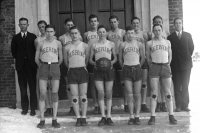
“Some things haven’t changed,” said Bates head baseball coach Jon Martin after seeing a film clip of a 1930s Bobcat ballplayer slashing a sharp single to right field, driving in a run.
Martin and several fellow coaches recently took time to offer critiques of a few Bobcats captured on film in the 1930s playing baseball, tennis, and track and field. (All male sports, it must be said.) The clips are courtesy of the Muskie Archives and Special Collections Library.
Baseball player: “I bet he’s a clutch hitter”
This is a 1930s baseball game on the old Garcelon Field diamond, near where the Residential Village now sits. Research suggests it might be a Bates victory over the University of Maine from 1936.
What’s changed, Martin notes, is the height of the mound, which seems lower than today’s 10 inches. A pitcher tries to throw downhill — that is, throw at a downward angle — so a flatter mound makes that harder, helping the hitter.
Pitchers throw in different “slots,” from sidearm to overhand. This pitcher has a “three-quarter arm slot, which appears to be natural, loose, and easy,” says Martin. “And I would predict this type of pitcher could master a two-seam fastball and/or sinker.”
The Bates hitter looks to have a great “two-strike approach,” meaning he’s trying to make contact to score the runner from third base.
“I bet he’s a clutch hitter,” Martin says, noting how the batter attacks the outside pitch and drives it to right field. “I love it. This guy could hit in my lineup any day.”
The batter’s hat-snatch caught Martin’s eye, too. “You’re much faster on the base paths without it!”
Tennis player: Spin and slice
This clip from the 1930s probably shows two-time Maine collegiate tennis champion Don Casterline ’38 competing on the old clay courts that were once next to Alumni Gymnasium.
Though Casterline is playing tennis, he’s playing a very different style of the game, says Bates tennis coach Paul Gastonguay ’89.
https://youtu.be/wKLmS-6WR5s
Casterline is using the Continental Grip, effective “for putting under-spin and slicing the ball” on the primary court surfaces of the day, which were clay and, especially, grass.
Today’s game is all about power and topspin, the goal being to send a “heavy ball” sizzling over the net.
“Change of pace and underspin, the primary tactics in the 1930s, are still used, but as a complement to the power topspin game,” Gastonguay says.
For example, where Casterline strikes the ball when it’s even with his body, today’s player would strike the ball perhaps 2 feet in front, to put more power into the stroke.
“It’s an upward arc,” he says, “to maximize racquet speed and put topspin on the ball, because that’s what’s being measured: the revolutions on the ball. The spin rate.”
As in other sports, notably golf, today’s equipment is vastly different, and it’s not just the racquet construction. “The most important change is the string technology,” Gastonguay says.
Natural gut string of the past “had a nice feel,” he says. “Now it’s all synthetic. We use Solinco Tour Bite that actually has edges,” rather than a round profile. “It bites the ball,” he says. “So the racquet grabs the ball, putting even more spin into it.”
Hammer thrower: Fancy footwork
“I’d take him on the team right now!”
So said Al Fereshetian, men’s track and field coach, after seeing this circa-1935 film clip of famed Bates thrower Anton “Tony” Kishon ’37 in action, probably on Garcelon Field.
“His form and technique are good,” Fereshetian says. “He’s relaxed and fluid. He’s not a big guy, which means he had to be better technically than others.”
Kishon won the hammer throw at the 1935 NCAA outdoor championships, held at Berkeley’s Edwards Stadium.
If there’s a difference in throwing style since the 1930s, says Fereshetian, it’s the footwork, which is key to the speed of the hammer.
Today, a Fereshetian-coached thrower would, within each turn, try to spend more time with both feet in contact with the ground. “That would mean ‘catching’ the ball earlier and rotating the right foot deeper into the turn before it leaves the ground.”
Pole vaulter: High athleticism
Showing pole vaulters on Garcelon Field, this clip is from the State Meet on May 11, 1935.
The second competitor is Lou Meagher ’35, who cleared 11 feet, 6 inches, to win the event, defeating competitors from Colby and the University of Maine.
Meagher is likely carrying a bamboo pole, which would be replaced by aluminum and steel in mid-century, then by today’s fiberglass or carbon fiber.
Nowadays,”vaulters land on their backs into foam pits,” says Jennifer “Jay” Hartshorn, head coach of women’s track and field. Back then, they landed on dirt — and on their feet. “The event would be as much about landing safely along with clearing the bar.”
Al Fereshetian is impressed by what he sees: “Athleticism has always been high here at Bates and in our state competition.”
Technically, the vaulters’ approaches “look very similar to the modern-day vault. I would say that these guys would be 14- or 15-foot jumpers if they were using fiberglass poles.” (The Bates records are 16 feet, 1/4 inch, for the men and 11 feet, 7 3/4 inches, for the women.)
But nearing takeoff, there’s a big difference, Fereshetian says. The vaulters change from a “wide-grip carry,” with hands far apart on the pole, to a closer grip. Given the stiffer bamboo poles, a narrower grip helped the vaulter to leverage, or bend, the pole to “help them invert” — achieving the classic upside-down look of a vaulter.
“But the objective is the same as today,” says Fereshetian. “Take your runway speed and convert it to pole rotation so that the pole gets to vertical prior to clearing the bar.”
High jumper: “Adaptation for survivability”
This is Garcelon Field, circa 1935, and we believe it’s Robert Kramer ’35, who won the state high-jump title his senior year.
This was decades before Dick Fosbury invented his famed flop, so Kramer is jumping scissors style, but with a twist — “an adaptation for survivability,” says Fereshetian.
Back then, you landed on dirt. “It was fluffed up, but still dirt,” says Fereshetian. It behooved jumpers to “come back down on your legs,” he says, which is what the scissors style allowed.
Kramer’s twist is just that: After clearing the bar, he twists his body to his left. “That lets him land safely on his hands and knees,” rather than on his feet, Fereshetian says.
In fact, Kramer’s twist makes his style “actually closer to the Fosbury flop” than other jumping styles of the mid-1900s.




